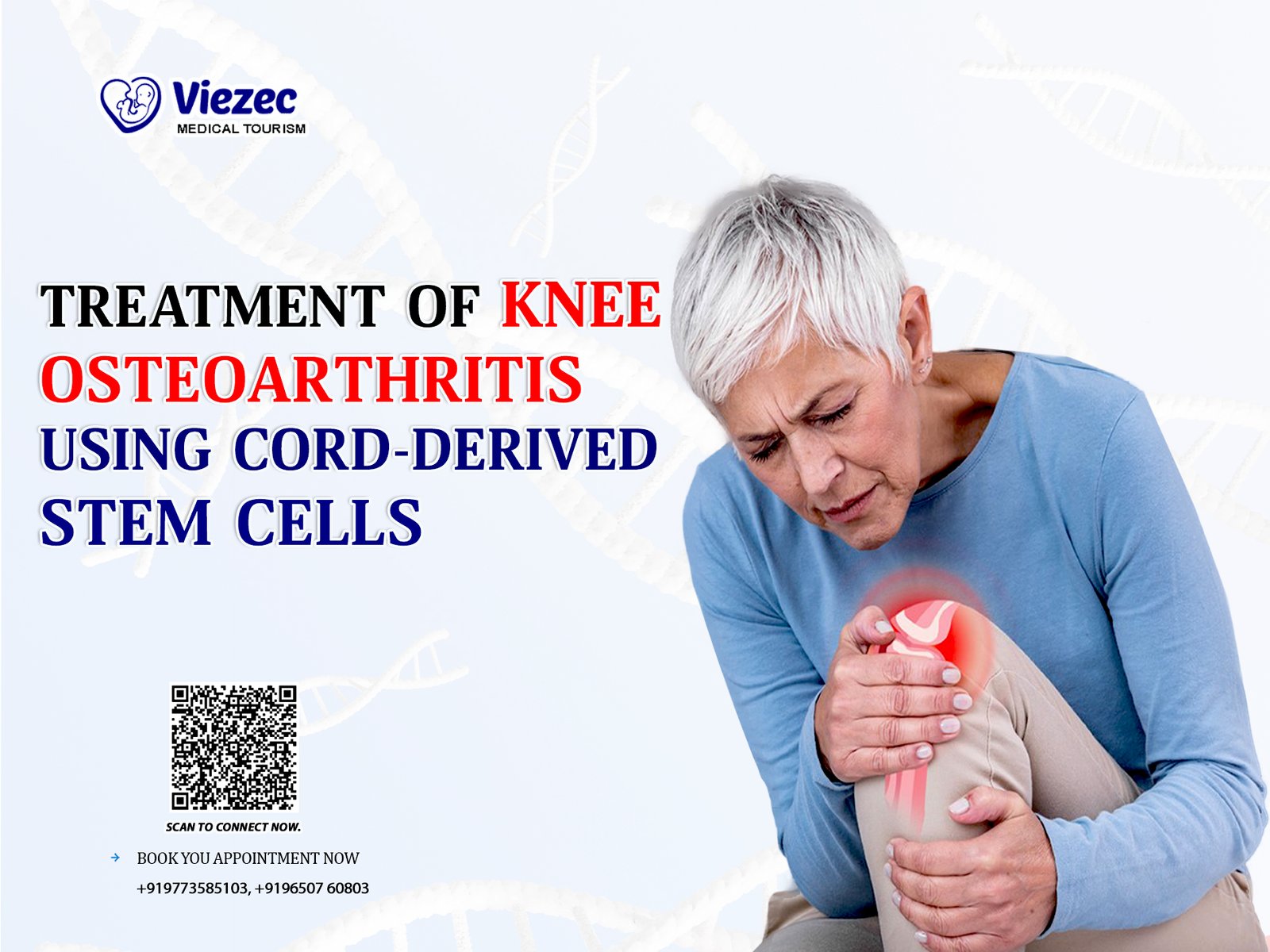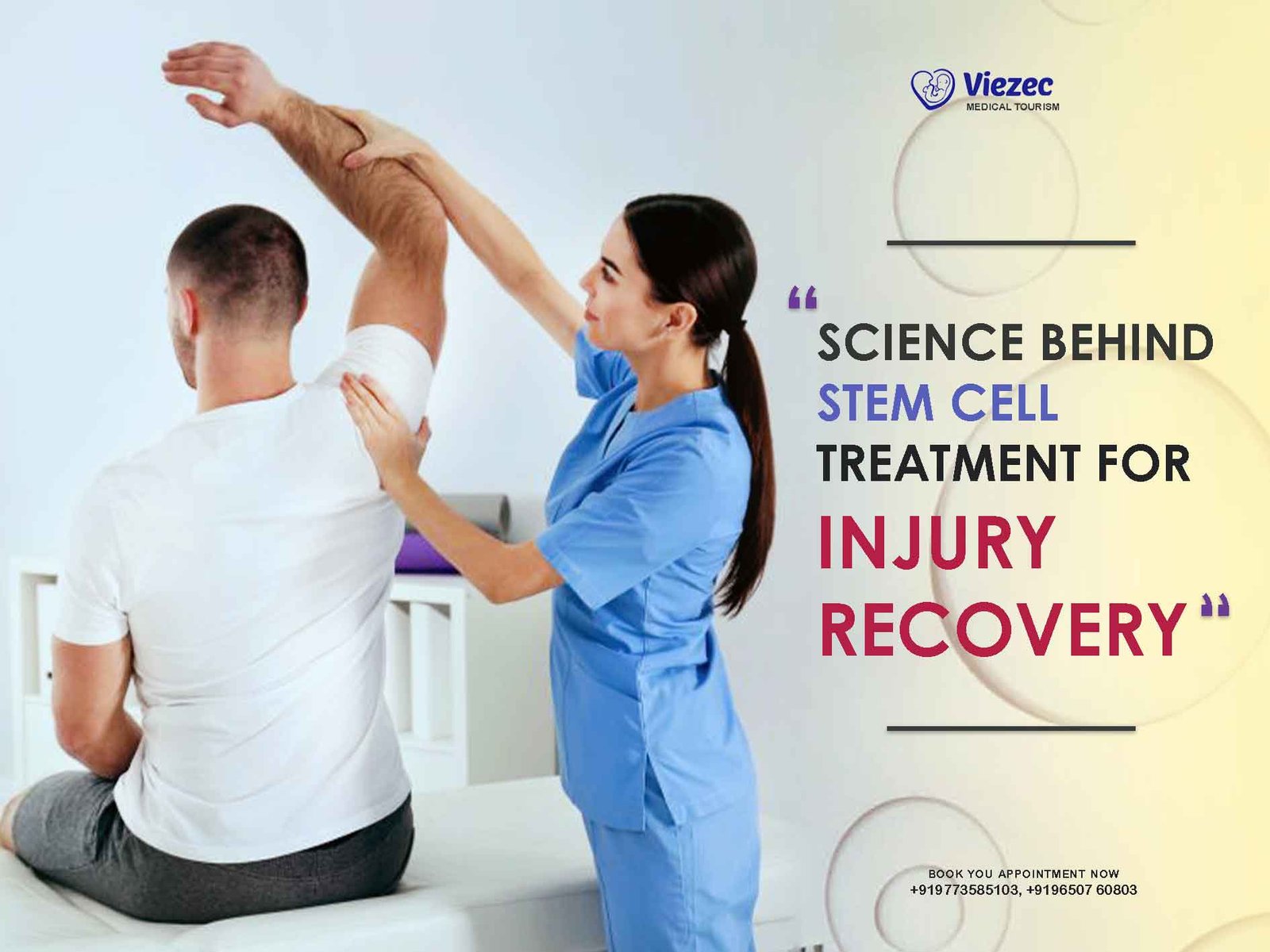KEY TAKEAWAYS
Stem cell therapy, especially treatments using umbilical cord–derived stem cells, is emerging as a promising option for knee osteoarthritis (OA). These mesenchymal stem cells (MSCs) have shown potential to regenerate damaged cartilage, reduce inflammation, and improve mobility in affected knee joints. While research is still ongoing, early studies indicate that this innovative therapy could provide lasting relief and better joint function for OA patients. For individuals seeking alternatives to surgery or long-term pain medications, stem cell therapy for knee osteoarthritis may represent a breakthrough in regenerative medicine.
What is Knee Osteoarthritis?
Knee osteoarthritis (knee OA) is a degenerative joint condition where the protective cartilage in the knee wears down, causing painful bone-on-bone friction and inflammation. Over time, this breakdown can also impact the surrounding bone, ligaments, and joint lining, leading to reduced joint stability. Knee OA is one of the most common causes of chronic knee pain, especially in older adults. Contributing factors include aging, family history, obesity, repetitive stress, and previous knee injuries. Understanding how knee osteoarthritis develops is the first step in exploring effective treatment options.
Symptoms and Progression of Knee Osteoarthritis
The symptoms of knee osteoarthritis may begin mildly and gradually worsen over time. Common signs include:
-
Pain: Initially felt during physical activity but can progress to constant pain, even at rest.
-
Stiffness: More noticeable in the morning or after long periods of inactivity.
-
Swelling: Inflammation may cause visible swelling in the knee joint.
-
Limited Range of Motion: Difficulty bending or straightening the knee fully.
-
Grating or Popping Sensation (Crepitus): Grinding or cracking sounds when moving the joint.
-
Instability: The knee may feel weak or as if it could “give way.”
Knee OA progression is often slow, with symptoms worsening gradually, but some patients experience flare-ups marked by sudden pain, swelling, and reduced mobility. Recognizing these warning signs early can help in managing the condition before it becomes more severe.
Limitations of Traditional Treatments for Knee Osteoarthritis
Conventional knee osteoarthritis treatments primarily focus on managing pain and improving mobility rather than reversing joint damage. Common approaches include:
-
Pain Medications: NSAIDs, acetaminophen, or opioids for temporary relief (with potential side effects).
-
Physical Therapy: Exercises to strengthen muscles, enhance flexibility, and reduce strain on the joint.
-
Lifestyle Changes: Weight management, low-impact activities, and assistive devices like braces or canes.
-
Injections: Corticosteroids or hyaluronic acid to reduce inflammation and pain for short-term relief.
-
Surgery: In advanced cases, total knee replacement may be recommended.
While these methods provide some relief, they often do not address the root cause of cartilage damage. Medications may lose effectiveness over time, physical therapy has limitations in advanced stages, and surgery carries risks, recovery time, and high costs. Importantly, there is still no permanent cure for knee osteoarthritis, which is why many patients explore regenerative options like stem cell therapy for long-term improvement.
What Are Cord-Derived Stem Cells?
Cord-derived stem cells, particularly umbilical cord stem cells (UC-MSCs), are a type of mesenchymal stem cell (MSC) found in the umbilical cord. These powerful regenerative cells are gaining attention in modern medicine because of their ability to repair, regenerate, and modulate immune function. The umbilical cord, especially Wharton’s jelly, the vein, and arteries, serves as a rich and non-invasive source of MSCs, making it one of the most preferred options for stem cell therapies.
Mesenchymal Stem Cells (MSCs) from the Umbilical Cord
-
Multipotent Differentiation: UC-MSCs can transform into multiple types of cells, including bone, cartilage, fat, and even nerve cells. This makes them highly versatile in regenerative treatments.
-
Low Immunogenicity: Unlike other sources of stem cells, UC-MSCs are less likely to trigger rejection by the recipient’s immune system. This makes them an excellent choice for allogeneic stem cell transplants (cells donated from another person).
-
Rich Source: The umbilical cord naturally provides a large supply of MSCs, making it accessible without invasive procedures or ethical concerns.
How Umbilical Cord Stem Cells Promote Tissue Regeneration
UC-MSCs play a vital role in healing and regeneration through multiple mechanisms:
-
Cell Replacement – They directly differentiate into the specific cell types needed to repair damaged tissues such as cartilage, bone, or nerves.
-
Secretion of Growth Factors & Cytokines – These cells release bioactive molecules that encourage cell survival, tissue growth, and immune regulation.
-
Immune System Modulation – UC-MSCs help suppress harmful immune responses, which reduces inflammation and prevents rejection of transplanted cells.
-
Paracrine Effects – By releasing signaling molecules, they influence surrounding cells to promote faster and more effective regeneration.
The Potential of Mesenchymal Stem Cells in Medicine
Umbilical cord MSCs are being researched and applied across a wide range of medical fields:
-
Tissue Engineering: Scientists are exploring how UC-MSCs can be used to create functional tissues and even organs for transplantation in the future.
-
Gene Therapy: UC-MSCs can act as delivery systems for therapeutic genes, helping repair tissues at the genetic level.
-
Treatment of Diseases: Early studies show promise in using UC-MSCs for conditions like knee osteoarthritis, cardiovascular disease, neurological disorders, autoimmune diseases, and more.
Clinical Studies and Research on Stem Cell Therapy for Knee Osteoarthritis
Mesenchymal Stem Cells (MSCs) and Their Role
Mesenchymal stem cells (MSCs), sourced from bone marrow, adipose tissue, and especially umbilical cord tissue, are at the center of regenerative medicine research for knee osteoarthritis. These cells have the unique ability to differentiate into chondrocytes (cartilage-forming cells), making them highly relevant in efforts to restore damaged knee cartilage and improve long-term joint health.
Potential Benefits of MSC Therapy
Clinical evidence suggests that MSC therapy for knee osteoarthritis may help:
-
Reduce chronic knee pain and stiffness.
-
Improve overall joint mobility and function.
-
Potentially slow the progression of osteoarthritis by protecting cartilage.
For patients seeking non-surgical options, MSC therapy could become a viable alternative to conventional treatments.
How MSCs Work: Key Mechanisms
Researchers believe MSCs support knee repair through multiple pathways, including:
-
Cartilage Repair: Differentiating into chondrocytes to rebuild damaged cartilage.
-
Growth Factor Secretion: Releasing natural proteins that stimulate the body’s repair process.
-
Inflammation Control: Modulating immune responses to reduce inflammation, which otherwise hinders cartilage healing.
Clinical Trials and Ongoing Research
Dozens of clinical trials on stem cell therapy for knee OA are underway worldwide. Many focus on umbilical cord-derived MSCs delivered via intra-articular injections, while others test MSCs combined with scaffolds or biomaterials to enhance tissue engineering. Early results are encouraging, but more long-term studies are needed to confirm safety and durability of outcomes.
Safety Profile of MSC Therapy
Most published studies report that MSC therapy is safe, with no serious adverse effects noted. Mild and temporary side effects such as soreness or swelling at the injection site may occur. Researchers continue to evaluate long-term safety outcomes to ensure this therapy’s reliability for widespread use.
Effectiveness and Variables
The efficacy of MSC therapy for knee osteoarthritis varies based on factors like:
-
Stem cell source (umbilical cord, bone marrow, or adipose tissue).
-
Dosage and number of injections.
-
Delivery methods (injection alone vs. scaffolds).
-
Patient characteristics, including severity of OA and age.
While some trials show significant pain reduction and cartilage regeneration, others report more modest improvements.
Comparison With Other Knee OA Treatments
Unlike short-term relief options such as corticosteroid injections, platelet-rich plasma (PRP), or viscosupplementation (hyaluronic acid), stem cell therapy aims to repair and regenerate cartilage, addressing the root cause rather than only symptoms. This positions MSC therapy as a potential long-term solution or complement to existing treatments.
Human Umbilical Cord Mesenchymal Stem Cells (hUC-MSCs)
Why Umbilical Cord Stem Cells Show Promise
Human umbilical cord-derived mesenchymal stem cells (hUC-MSCs) are gaining attention due to their abundance, low immunogenicity, and regenerative potential. Studies reveal that hUC-MSC therapy for knee osteoarthritis can promote cartilage regeneration and provide sustained improvements in pain and function—sometimes showing better results than placebo or traditional treatments.
How Cord Stem Cells Repair Damaged Cartilage
-
Differentiation: hUC-MSCs can transform into chondrocytes that directly replace lost cartilage.
-
Paracrine Effects: They release signaling molecules and growth factors that stimulate the body’s own repair mechanisms.
-
Immunomodulation: By reducing inflammation inside the joint, hUC-MSCs create a more favorable environment for healing.
-
Scaffold Support: When combined with biomaterial scaffolds, these cells integrate more effectively, supporting tissue engineering.
-
Synergistic Benefits: Pairing hUC-MSCs with cartilage matrix components may amplify regenerative effects, enhancing outcomes for patients.
The Stem Cell Therapy Process: Step by Step
Stem cell therapy for knee osteoarthritis and other joint conditions usually follows a carefully planned, multi-step process. This includes an initial consultation and evaluation, the actual stem cell injection procedure, and post-treatment care with rehabilitation. Each step is designed to maximize patient safety and improve the chances of long-term recovery.
Consultation and Evaluation
Before beginning stem cell treatment, patients undergo a thorough assessment to determine whether they are a good candidate for therapy.
-
Medical History Review: Doctors review past medical records, allergies, medications, and prior treatments to ensure a safe approach.
-
Physical Examination: A complete physical check-up helps identify the severity of the knee or joint issue.
-
Imaging Tests: MRI scans or X-rays are often used to evaluate cartilage damage or inflammation levels.
-
Laboratory Testing: Blood work may be conducted to confirm overall health and rule out any underlying risks.
-
Stem Cell Source Selection: Based on the patient’s condition, stem cells may be sourced from bone marrow, adipose (fat) tissue, or donated umbilical cord blood.
Stem Cell Injection Procedure
The stem cell injection procedure is performed with precision to deliver regenerative cells directly to the affected joint.
-
Stem Cell Harvesting: Depending on the source, stem cells are collected either from the patient (autologous) or from a donor (allogeneic).
-
Stem Cell Processing: Harvested cells are purified and prepared for therapy to ensure optimal effectiveness.
-
Targeted Administration: Stem cells are injected directly into the damaged knee joint or targeted area.
-
Sterile Environment: The procedure is carried out in a sterile clinical setting to minimize infection risks.
-
Patient Comfort: Local anesthesia or numbing agents are often used to make the process comfortable.
Post-Treatment Care and Rehabilitation
After stem cell therapy, recovery and aftercare play a key role in achieving the best possible results.
-
Ongoing Monitoring: Follow-up visits allow physicians to track progress, healing, and improvements in joint function.
-
Rehabilitation: Physical therapy may be recommended to rebuild strength, mobility, and flexibility in the knee.
-
Pain Management: Strategies such as medications or non-invasive therapies may help reduce discomfort.
-
Lifestyle Modifications: Patients are often advised to follow a joint-friendly diet, maintain a healthy weight, and adopt safe exercise routines to support healing and prevent future damage.
Benefits and Outcomes of Stem Cell Therapy for Joint Pain
Stem cell therapy is gaining recognition as a regenerative approach to managing chronic joint pain. Unlike conventional treatments that only provide temporary relief, stem cell therapy focuses on repairing damaged tissues and restoring joint health. Here are the key benefits and outcomes patients may experience:
Reduced Pain and Inflammation
One of the most significant advantages of stem cell therapy is its ability to target the root cause of joint discomfort. Stem cells release anti-inflammatory properties that help reduce swelling, stiffness, and chronic pain in the affected area. For individuals struggling with arthritis or other degenerative conditions, this approach may provide a more sustainable solution compared to painkillers or injections.
Improved Joint Function and Mobility
By lowering inflammation and promoting tissue repair, stem cell therapy can improve joint function and restore mobility. Patients often notice an increased range of motion, reduced stiffness, and greater ease in performing everyday activities. This can be especially beneficial for those with knee, hip, or shoulder osteoarthritis, where mobility is often severely impacted.
Long-Term Relief and Enhanced Quality of Life
Unlike short-term therapies, stem cell treatment aims to deliver lasting results. With reduced pain and better mobility, patients are able to maintain an active lifestyle, engage in hobbies they enjoy, and avoid dependency on long-term medications. This long-term improvement directly contributes to an overall better quality of life.
Other Potential Benefits of Stem Cell Therapy
-
Delaying or Avoiding Surgery: In many cases, effective stem cell treatments can postpone or eliminate the need for invasive procedures such as joint replacement surgery.
-
Holistic Health Improvement: By reducing systemic inflammation, stem cell therapy may also support overall wellness beyond just joint health.
-
Supporting Independence: Enhanced joint strength and flexibility help individuals maintain independence, stay socially active, and enjoy daily life without constant limitations.
Stem Cell Therapy for Knee Osteoarthritis: Is It Right for You?
Stem cell therapy, particularly for knee osteoarthritis, is gaining attention as an innovative approach in regenerative medicine. Research suggests it may help repair damaged cartilage, reduce inflammation, and relieve chronic knee pain. However, it’s important to note that this therapy is not a universal solution. Effectiveness varies depending on individual health conditions, severity of osteoarthritis, and lifestyle. Consulting with an orthopedic or regenerative medicine specialist is essential to determine whether stem cell therapy is the right treatment option for your specific needs.
Who Are the Best Candidates for Stem Cell Therapy?
Active individuals with recent injuries
Athletes or physically active people who experience knee injuries may benefit from stem cell therapy, as it supports tissue healing and reduces the risk of long-term joint damage.
Patients with mild to moderate knee osteoarthritis
Stem cell therapy can potentially restore cartilage, reduce stiffness, and minimize pain in patients who are not yet in the advanced stages of OA.
Individuals seeking alternatives to surgery
For patients hoping to avoid or delay knee replacement surgery, stem cell therapy may provide a less invasive alternative that improves mobility and quality of life.
Essential Questions to Ask Your Doctor Before Treatment
What is the source of the stem cells?
Options may include bone marrow, adipose tissue, or umbilical cord–derived cells, each with unique properties.
What type of stem cells and protocol will be used?
Since standardized protocols are still being developed (Swiss Medica), it’s important to understand the method your clinic follows.
What benefits and risks should I expect?
While usually considered safe, possible side effects may include pain, infection, or limited results.
What are the long-term outcomes?
Research is ongoing, and clinical trials are still assessing how durable the improvements are for knee osteoarthritis patients.
What is the cost of stem cell therapy?
Because it is often not covered by insurance, costs can be significant, and patients should budget accordingly.
How does it compare to alternatives like PRP or surgery?
Discussing all available options ensures you make the best choice for your condition.
The Future of Knee Osteoarthritis Treatment
-
Continued research and clinical trials are refining stem cell protocols and studying long-term safety and effectiveness.
-
Improved standardization of cell sources, types, and dosages is expected to make treatment outcomes more consistent (Swiss Medica).
-
Expanded applications of stem cell therapy may include broader uses in musculoskeletal and joint disorders beyond knee OA.
-
Combination with other regenerative therapies like PRP, microfracture, or hyaluronic acid injections could offer enhanced, synergistic benefits.
Important Considerations Before Choosing Stem Cell Therapy
-
Stem cell therapy for knee osteoarthritis is still regarded as investigational by the FDA.
-
Results vary, and while many patients experience relief, it may not work for everyone.
-
A detailed discussion with your doctor about the potential risks, benefits, and alternatives is crucial.
-
Be prepared for out-of-pocket expenses since insurance coverage is limited.










